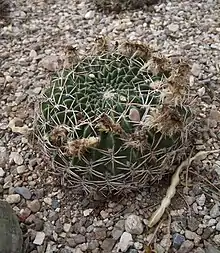| Lobivia cinnabarina | |
|---|---|
 | |
| Scientific classification | |
| Kingdom: | Plantae |
| Clade: | Tracheophytes |
| Clade: | Angiosperms |
| Clade: | Eudicots |
| Order: | Caryophyllales |
| Family: | Cactaceae |
| Subfamily: | Cactoideae |
| Genus: | Lobivia |
| Species: | L. cinnabarina |
| Binomial name | |
| Lobivia cinnabarina | |
| Synonyms | |
|
List
| |
Lobivia cinnabarina is a species of cactus first described in 1885.[2]
Description
Lobivia cinnabarina grows singly with flattened, spherical, bright green shoots that reach a diameter of up to 15 centimetres (5.9 in). The shoot apex is depressed and not thorny. There are around 20 irregular and crooked ribs, which are clearly divided into crooked cusps. The two to three central spines are slightly curved. The eight to twelve slender marginal spines are slightly curved and 0.6 centimetres (0.24 in) to 1.2 centimetres (0.47 in) long.
The bell-shaped, funnel-shaped scarlet flowers appear on the side or on the shoot shoulder and open during the day. They reach a diameter of up to 4 centimetres (1.6 in).[3]
Distribution
Lobivia cinnabarina is widespread in the Bolivian departments of Cochabamba, Potosí and Chuquisaca, in the Andes at elevations between 2500 to 3400 meters.
Taxonomy
The first description as Echinocactus cinnabarinus by William Jackson Hooker was published in 1847.[4] The specific epithet cinnabarina comes from Latin, means 'vermilion red' and refers to the color of the flowers. Nathaniel Lord Britton and Joseph Nelson Rose placed the species in the genus Lobivia in 1922.[5] Other nomenclature synonyms include Echinopsis cinnabarina (Hook.) Labor. (1853), Echinocereus cinnabarinus (Hook.) K.Schum. (1894) and Cinnabarinea cinnabarina (Hook.) Frič ex F.Ritter (1980).[6] In addition, numerous taxonomic synonyms are known because the species is very variable.
References
- ↑ "The IUCN Red List of Threatened Species". IUCN Red List of Threatened Species. 2010-09-22. Retrieved 2023-10-07.
- ↑ Nathaniel L. Britton; J.N. Rose (1963). Cactaceae: Descriptions and Illustrations of Plants of the Cactus Family. Dover Publications. p. 54. ISBN 0486211924.
- ↑ Anderson, Edward F.; Eggli, Urs (2005). Das grosse Kakteen-Lexikon (in German). Stuttgart (Hohenheim): Ulmer. p. 225. ISBN 3-8001-4573-1.
- ↑ Curtis, William; Hooker, Joseph Dalton; Hooker, William Jackson; Prain, D.; Stapf, O.; Trust., Bentham-Moxon; Trust., Bentham-Moxon; Gardens, Royal Botanic; Trust, Stanley Smith Horticultural; Trust., Stanley Smith Horticultural (1847). "Curtis's botanical magazine". Academic Press [etc.] ISSN 0011-4073. Retrieved 2023-10-07.
- ↑ Britton, Nathaniel Lord; Eaton, Mary E.; Rose, J. N.; Wood, Helen Adelaide (1919). The Cactaceae : descriptions and illustrations of plants of the cactus family. Washington: Carnegie Institution of Washington. doi:10.5962/bhl.title.46288.
- ↑ Labouret, J. (1853). Monographie de la Famille des Cactées. ... Suivie d'un traité complet de culture, et d'une table alphabétique des espèces et variétés (in French). Dusacq. p. 288. Retrieved 2023-10-07.
External links
 Media related to Lobivia cinnabarina at Wikimedia Commons
Media related to Lobivia cinnabarina at Wikimedia Commons Data related to Lobivia cinnabarina at Wikispecies
Data related to Lobivia cinnabarina at Wikispecies
